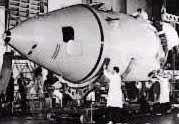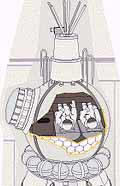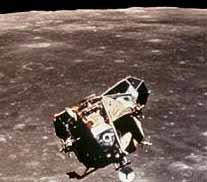|
> History > Manned Space Programs > Recent & Future Developments
|
Within a year of the successes of the first small artificial satellites in 1957 and 1958, both the United States and the USSR were developing programmes to place people in Earth orbit. But first they sent carefully monitored dogs and primates into orbit to study the effects of weightlessness on living creatures. Vostok and Mercury ProgramsThe USSR was first into space with a man, cosmonaut Yury A. Gagarin, who made one orbit of the Earth in Vostok 1 on April 12, 1961. During his flight time of 1 hour, 48 minutes, he reached a maximum height of 327 km (203 mi) above the Earth. He landed safely in Siberia. In the next two years five more Vostok flights were made. The pilot of Vostok 6 was Valentina Tereshkova, the first woman to fly in space. Launched on June 16, 1963, she orbited the Earth 48 times.
[Top] Voskhod and Gemini ProgramsThe Voskhod was an adaptation of the Vostok spacecraft, modified to accommodate two or three cosmonauts. On October 12, 1964, cosmonauts Vladimir M. Komarov, Boris B. Yegorov, and Konstantin P. Feoktistov made a 15-orbit flight in Voskhod 1. This was the only piloted flight that year and brought the total cumulative man-hours of Soviet cosmonauts in space to 455. The American astronauts then had a total of 54 man-hours in space. On March 18, 1965, cosmonauts Pavel I. Belyayev and Aleksei A. Leonov were launched in Voskhod 2. During this 17-orbit flight, Leonov performed the first walk in space, or extravehicular activity (EVA), leaving the spacecraft and drifting out on an umbilical tether.
The US Gemini programme was designed to develop the
technology required to go to the Moon. In May 1961, US President John F.
Kennedy had instituted the Apollo programme, designed to land a man on the
Moon and return him safely to the Earth “before the decade is out”. This
national commitment resulted in an intensive, large-scale, piloted flight
programme. The Gemini spacecraft carried two astronauts and was designed
to operate for extended periods of time and to develop rendezvous and
docking techniques with another orbiting spacecraft. Ten manned Gemini
flights were made in 1965-1966.
By the end of the last Gemini flight in November 1966, US astronauts had accumulated nearly 2,000 man-hours in space, which exceeded the Soviet cosmonauts’ total, and about 12 hours of EVA. [Top] Soyuz and Apollo The year 1967 was one of tragedy for both
spacefaring nations. On January 27, during a ground test of the Apollo
spacecraft at Cape Kennedy, fire broke out in the three-man command
module. Because of the pressurized pure-oxygen atmosphere inside the
spacecraft, it engulfed and killed the three astronauts—Grissom, White,
and Lieutenant Commander Roger B. Chaffee of the navy. As a result of this
tragedy, the Apollo programme was delayed by more than a year while
vehicle design and materials underwent a major review.
In October 1968, the first manned Apollo flight was
launched by a Saturn 1B booster rocket. Astronauts Schirra, Major R.
Walter Cunningham of the US Marine Reserve Corps, and Major Donn F. Eisele
of the air force circled the Earth for 163 orbits, checking spacecraft
performance, photographing the Earth, and transmitting television
pictures. In December 1968, Apollo 8, a landmark flight carrying
astronauts Borman, Lovell, and Major William A. Anders of the air force,
orbited the Moon ten times and returned safely to Earth. The Apollo 9
flight, with Major James A. McDivitt and Colonel David R. Scott of the air
force and Russell L. Schweickart, a civilian, tested undocking,
rendezvous, and docking of the Apollo lunar module (LM) landing craft
during a 151-orbit mission. The Apollo 10 flight, with astronauts Stafford
and Lieutenant Commander John W. Young and Commander Eugene A. Cernan of
the navy, made 31 orbits of the Moon in a rehearsal for the lunar landing.
As planned, Stafford and Cernan transferred from the Apollo command module
(CM) to the LM, separated, and descended to within 16 km (10 mi) of the
lunar surface while astronaut Young piloted the CM. Subsequently,
rendezvous and docking of the ascent stage of the LM were accomplished;
the two astronauts then transferred to the CM, discarded the LM, fired the
service module rocket to enter the return trajectory to Earth, and
returned safely. Project Apollo was now ready to land astronauts on the
Moon.
|



